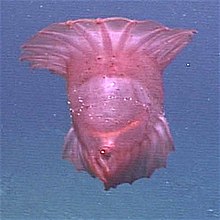| Enypniastes eximia | |
|---|---|

| |
| Scientific classification | |
| Domain: | Eukaryota |
| Kingdom: | Animalia |
| Phylum: | Echinodermata |
| Class: | Holothuroidea |
| Order: | Elasipodida |
| Family: | Pelagothuriidae |
| Genus: | Enypniastes |
| Species: | E. eximia
|
| Binomial name | |
| Enypniastes eximia | |
| Synonyms[2] | |
|
List (Genus): (Species):
| |
Enypniastes is a genus of deep-sea sea cucumber. It is monotypic, being represented by the single species Enypniastes eximia. Due to its unique appearance, the species has been dubbed the headless chicken fish, headless chicken monster, and the Spanish dancer.[3][4] It is also known as the swimming sea cucumber, and some are called the pink see-through fantasia.[5]
Description
[edit]Species in this genus have developed webbed swimming fin like structures at the front and back of their bodies which enable them to swim up off the surface of the sea floor and to journey as much as 1,000 m (3,300 ft) up into the water column. This is thought to help the animals move to new feeding grounds and avoid predators.[6]
The sea cucumber ranges in size from 11 to 25 centimeters (4.3 to 9.8 in).[7] Its most distinct feature is its coloring, which is dictated by size: small enypniastes are a bright pink, and larger individuals are a more reddish-brown color. It is also semi-transparent, and its intestine can be seen through its body, especially after feeding.[8] The enypniastes have a round bulbous body, bifurcated tentacles, and a large anterior sail. They can also be bioluminescent.[9]
Distribution and habitat
[edit]The enypniastes can be found mainly in the benthic zone of the ocean. They can be found all over the globe in many different regions.[7] They spend most of their time in the water column, touching down on the seafloor only to eat.[8]
The first sighting in the southern ocean waters occurred in October 2018,[10] when a team from Australia's Department of the Environment and Energy caught an image of E. eximia on a camera that had been deployed in seas near East Antarctica.[11]
Feeding
[edit]The enypniastes feed mostly on benthic sediment. They feed by pushing food into their mouths with their tentacles. They feed very quickly, staying on the seafloor for at most sixty four seconds. Since that is most enough time to feed fully, the enypniastes feed episodically.[8]
Movement
[edit]The enypniastes move using a few methods. The first is that they move their anterior veil in a rowing motion. The second is that when there is a current, the organism will use their tentacles to pull themselves down current. They also move using a pushing motion with their tentacles.[8]

Notes
[edit]- ^ Théel, Hjalmar (1882). Report on the Holothuroidea dredged by H.M.S. 'Challenger' during the years 1873-76. Part i. Report on the Scientific Results of the Voyage of H.M.S. Challenger during the years 1873–1876. Zoology. 4 (part 13): i-ix, 1–176, pl. 1-46., available online at http://19thcenturyscience.org/HMSC/HMSC-Reports/Zool-13/htm/doc.html
- ^ WoRMS (2020). Enypniastes Théel, 1882. Accessed at: http://www.marinespecies.org/aphia.php?p=taxdetails&id=123526 on 2020-03-28
- ^ Bright, Michael (2013). The Shark that Walks on Land: And Other Strange but True Tales of Mysterious Sea Creatures. Biteback Publishing. ISBN 9781849546645.
- ^ Clemens, Danny (October 21, 2018). "'Headless chicken monster' spotted swimming in Antarctic Ocean". KABC-TV. Retrieved October 21, 2018.
- ^ Albeck-Ripka, Livia (October 22, 2018). "'Headless Chicken Monster' Spotted in the Deep Sea". The New York Times. Retrieved October 23, 2018.
- ^ Miller, J. E.; Pawson, David L., Swimming Sea Cucumbers (Echinodermata: Holothuroidea): A Survey, with Analysis of Swimming Behavior in Four Bathyal Species, Smithsonian contributions to the marine sciences, no 35, 1990.
- ^ a b Solís-Marín, Francisco Alonso; Hooker, Yuri; Laguarda-Figueras, Alfredo (2012-10-02). "Primer registro del pepino de mar nadador Enypniastes eximia Theel, 1882 (Echinodermata: Holothuroidea) en aguas peruanas". Revista Peruana de Biología. 19 (1): 095–096. doi:10.15381/rpb.v19i1.793. ISSN 1727-9933.
- ^ a b c d Miller, J. E.; Pawson, David L. (1990-06-01). "Swimming sea cucumbers (Echinodermata: Holothuroidea): a survey, with analysis of swimming behavior in four bathyal species". Smithsonian Contributions to the Marine Sciences (35): 1–18. doi:10.5479/si.01960768.35.1. hdl:10088/1130. ISSN 0196-0768.
- ^ Robison, Bruce H. (May 1992). "Bioluminescence in the benthopelagic holothurian Enypniastes eximia". Journal of the Marine Biological Association of the United Kingdom. 72 (2): 463–472. doi:10.1017/S0025315400037826. ISSN 1469-7769. S2CID 85339536.
- ^ "Researchers just found a bizarre 'headless chicken monster' swimming deep in the Antarctic Ocean". USA Today. Retrieved 2018-10-22.
- ^ "Behold The Headless Chicken Of The Deep Sea". NPR. Retrieved 2018-10-23.
References
[edit]- Mah, Christopher (September 18, 2012). "Deep-Sea Swimming Sea Cucumbers and the "most bizarre holothurian species in existence"!". The Echinoblog.
- http://zipcodezoo.com/Animals/E/Enypniastes_eximia/
- The Blue Planet - http://www.bbc.co.uk/nature/blueplanet/factfiles/starfish_urchins/swimming_sea_cucumber_bg.shtml